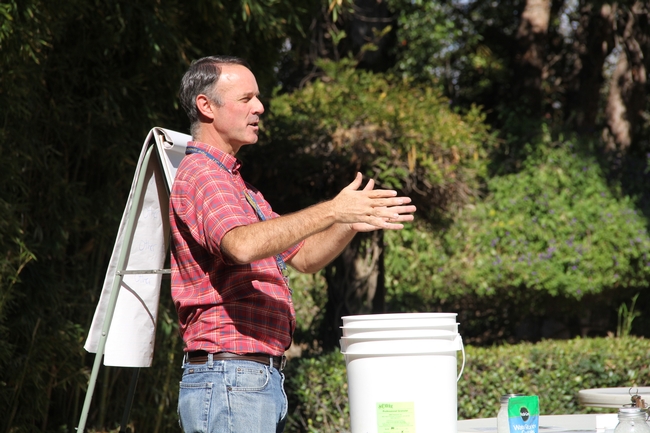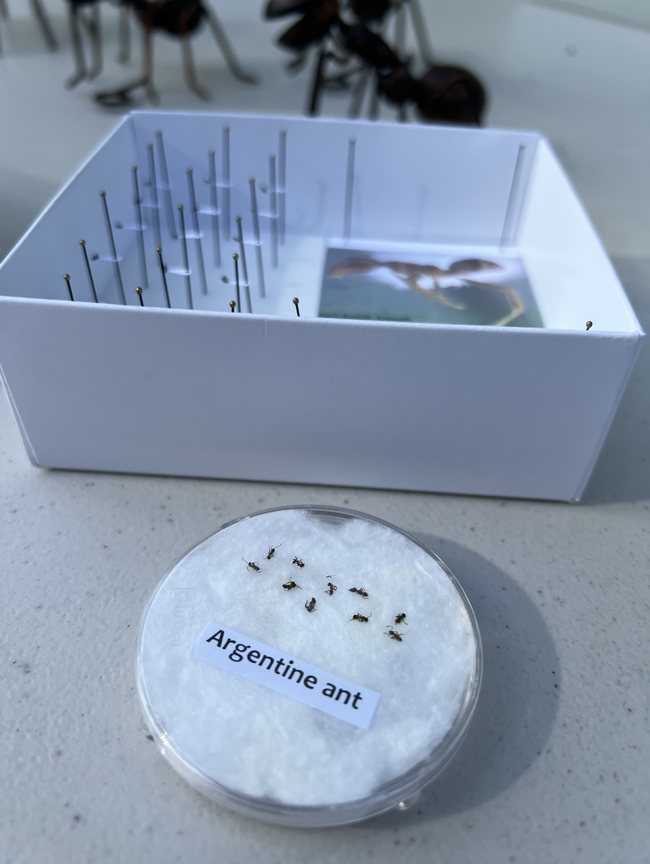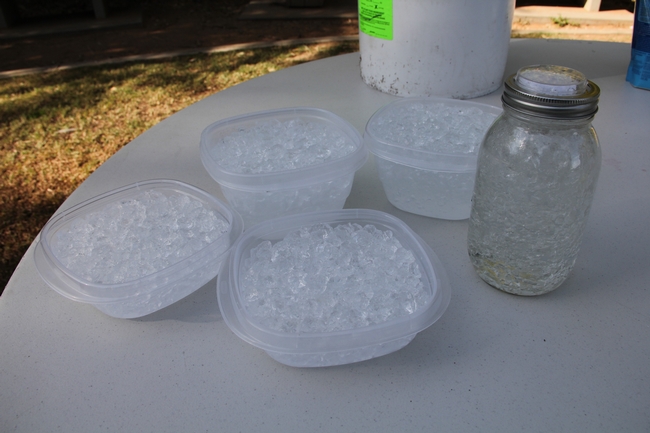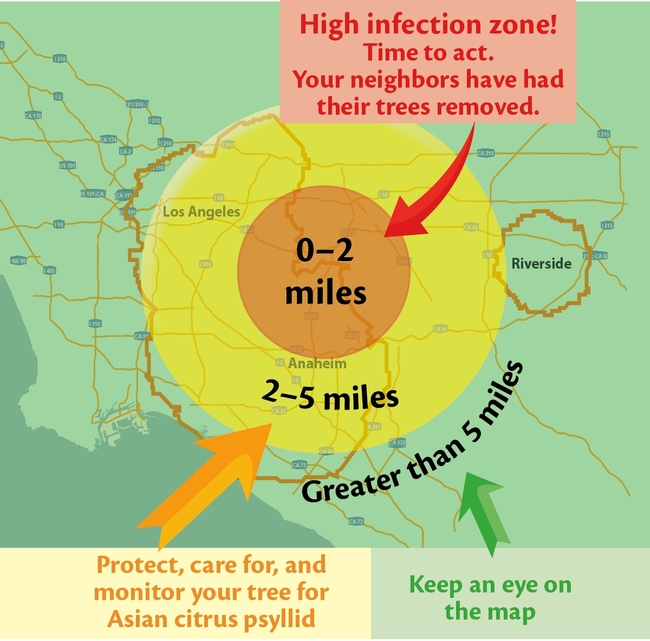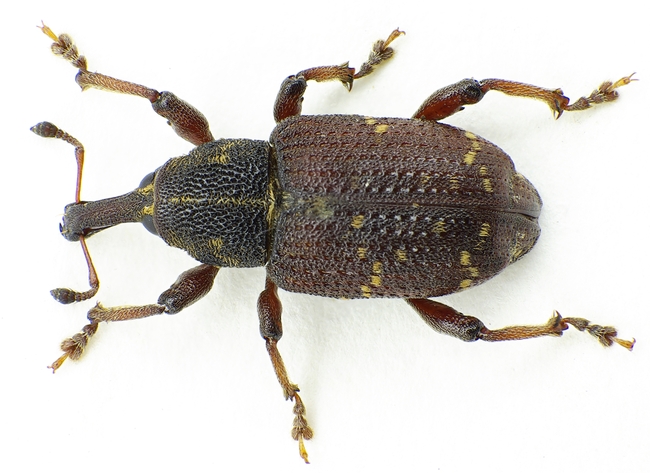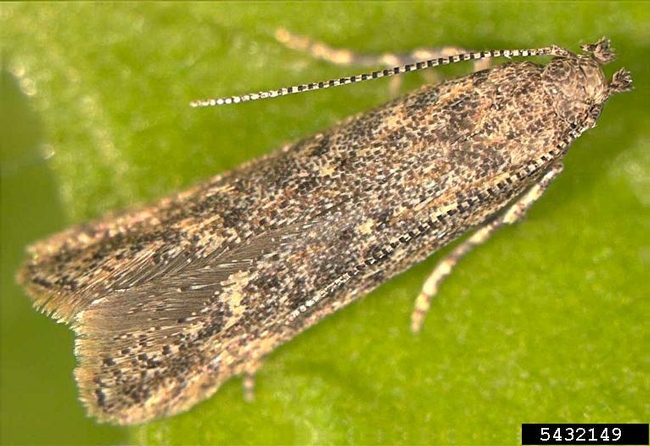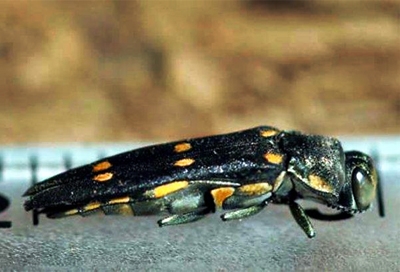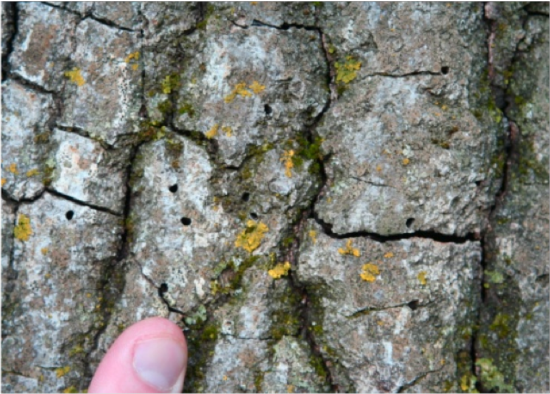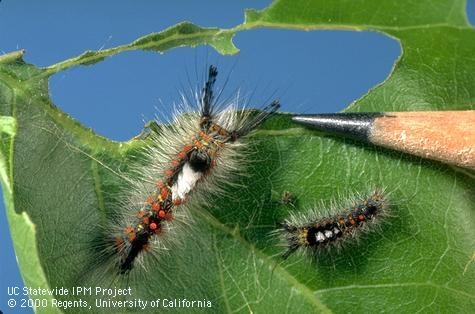Posts Tagged: Hoddle
UCCE researchers target sugar-feeding ants, a key to controlling citrus pests, disease
Sugar-feeding ants protect pests that infect trees and damage the fruit they bear. Insecticides are often a go-to solution, but may kill beneficial insects in the process, too. Thankfully, Mark Hoddle, University of California Cooperative Extension entomologist and biological control specialist at UC Riverside, together with UCR colleagues in chemical engineering, developed a biodegradable hydrogel baiting system that targets ant populations, which protect sap-sucking pests from their natural enemies. Control of ants allows beneficial parasitoids and predators to greatly reduce pest populations.
Deciding to expand Hoddle's research was a “no-brainer” according to David Haviland, UC Cooperative Extension farm advisor in Kern County.
Haviland is investigating active ingredients that can be effectively used in hydrogel baiting systems. His research builds on Hoddle's use of alginate gels, also known as water beads, soaked in sugar water to control Argentine ants.
“What we're doing in California can benefit places like Florida, Texas, Mexico and beyond,” Haviland said.
The Hoddle lab conducted two years of orchard research showing that when ants are controlled, the amount of citrus flush infested with Asian citrus psyllid (ACP), a mottled brown insect that vectors the pathogen causing citrus greening, decreases by 75%. Citrus flush refers to newly developed leaves.
“But benefits are not restricted to just ACP with Argentine ant control, as natural enemies destroy colonies of other sap-sucking pests too,” said Hoddle. “For example, citrus mealybug infestations on leaves were completely eliminated by natural enemies, 100% control, while densities of fruit infested by mealybugs were reduced by 50%.”
The Hoddle lab's success inspired Haviland to consider how this approach will fare in different regions of the state where there are different crops, different pests and different ant species.
Haviland has worked for many years on solid baits that are effective and affordable for ants that feed primarily on protein, like fire ants in almonds, but successful control measures for sugar-feeding ants that drink their food have been elusive.
“Therefore, we're using hydrogels to essentially turn a liquid bait into a solid, making it effective and commercially adoptable,” Haviland said. He and his team are assessing whether active ingredients that undoubtedly work against ants, like thiamethoxam, maintain their effects in a hydrogel system.
Unlike Hoddle's biodegradable alginate gels, Haviland is relying on acrylamide gels that are similar to the absorbing material you would find in a diaper. These gels are not organic, but are currently accessible on a commercial scale, and have been shown to be effective in wine grapes on the North Coast by a Cooperative Extension advisor in Napa County, Monica Cooper. Haviland's current research efforts are focused on citrus, table grapes and wine grapes in the San Joaquin Valley, and on lemons on the coast.
The primary challenge now is navigating pesticide regulations and registration.
“This is cutting-edge research,” Haviland said, and manufacturer labels for the products being used need to be updated to include hydrogels as an approved use. This process takes time. Additionally, adding new product uses needs to make economic sense for the manufacturer.
Hoddle and Haviland's research can provide data for adding these methods to the product labels.
“If we can show that this tech works against lots of pests, lots of ant species, in lots of different crops across California, hopefully we'll achieve a critical mass of benefits that motivates product manufacturers to make modifications to their labels,” said Haviland.
Haviland is hopeful about the process, and said he believes that UC ANR is in a prime position to lead innovation for an issue that requires collaboration among specialists, advisors and the industry.
Consult UC ANR's map to see how close you live to citrus with HLB disease
UC Cooperative Extension developed an online interactive map that allows Californians to see how close they live to citrus trees infected with huanglongbing disease, reported Jeanette Marantos in the Los Angeles Times. This information is critical for the more than 60% of Californians who are growing their own backyard orange, grapefruit, mandarin, lime and other citrus trees.
Huanglongbing is an exotic citrus disease that kills every tree it infects. An exotic insect, the Asian citrus psyllid, spreads the disease from tree to tree. If the disease makes its way into California's commercial citrus production regions, it threatens the state's valuable and iconic citrus industry.
Go to http://ucanr.edu/hlbapp and type in your address. If you are inside the red circle — within two miles of a hot zone — UCCE suggests you remove your citrus trees and plant different types of fruit trees, such as peaches, pears, apples or figs, until researchers find a cure. In the yellow circle — within two to five miles of a hot zone — consider replacing your tree with a non-citrus fruit tree or protect your citrus trees. Find detailed information on home citrus management here https://ucanr.edu/sites/ACP/Homeowner_Options/
“When we first started this program back in 2012, I was encouraging Master Gardeners to teach homeowners how to treat their trees [to discourage psyllids, which are the insects that spread HLB],” she said, “but the complaint came back from the Master Gardeners, ‘I treat my trees but none of my neighbors do, so what's the point?'” said Beth Grafton-Cardwell, UC Cooperative Extension entomology specialist and director of the Lindcove Research and Extension Center in Exeter.
Grafton-Cardwell said the threat is serious. HLB disease devastated Florida's citrus industry when it hit in 2005, destroying half of its acreage and production, and pretty much eliminating residential citrus.
The battle against the psyllid in California is being helped by the introduction in 2011 of Tamarixia radiata, a parasitic wasp native to Pakistan, by UC Cooperative Extension biological control specialist Mark Hoddle and his entomologist wife Christina Hoddle.
"We've had psyllid here [in California] since 2008, but we still have a lot of oranges,” Hoddle said. “The disease hasn't swept through California the way it did through Florida, and I believe our biological control program is why. Psyllid populations have decreased by 70% to 80% since our first parasite release in 2011. We haven't wiped out HLB in citrus trees, but we have mitigated the risk.”
Three UC ANR programs receive research grants from CDFA
The California Department of Food and Agriculture has awarded more than $1 million to fund three UC Agriculture and Natural Resources integrated pest management projects to research insects that have the potential to become pests in California agriculture. Each of the three-year projects received strong support from commodities which could be affected by invasive pests.
The projects that were awarded the funds are:
Proactive management of avocado seed and stem feeding weevils, led by UC Cooperative Extension specialist Mark Hoddle and entomology professor Jocelyn Millar, both at UC Riverside, will receive $348,893. This project will develop pheromones, identify natural enemies in the host range, and quantify flight capacity of the avocado seed weevils. Native to Mexico and invasive in Ecuador, these weevils feed directly on avocados and could cause substantial damage to the California avocado industry. The California Avocado Commission pledged an additional $150,000 to support this project. The work will be conducted at UC Riverside and in Mexico.
A proactive approach to prepare for the invasion of Tuta absoluta into California, led by UCCE specialist Ian Grettenberger, will receive $499,847. T. absoluta, a tomato leafminer, is a serious pest throughout Europe, Africa, western Asia and South and Central America and could decimate California's tomato industry. This project will proactively test targeted insecticides, identify native natural enemies that could be used in biological control, and conduct work to assist in breeding plants resistant to this pest. This project will be conducted at UC Davis, throughout California, and in Chile and Peru.
Detection, biology and control of the exotic Sweede midge for California cole crops, led by UCCE area IPM advisor Alejandro Del Pozo-Valdivia, UCCE specialist Ian Grettenberger and USDA research entomologist Daniel Hasegawa. Swede midge is a pest of cole crops in the Northeastern U.S. and Canada and could cause significant management issues for California's large cole crop industry. This project will collect important information about the biology of Swede midge, test low impact insecticides and botanical products as options for control, assess the possibility of weeds as alternative hosts, and work with growers to start monitoring for the pest. This project will be conducted at UC Davis and in the Salinas Valley.
Goldspotted oak borer continues to spread
The invasive beetle, goldspotted oak borer (GSOB), has been found in the mountain community of Sugarloaf near Big Bear in San Bernardino County, reported the Chino Champion. The detection causes concern for other nearby communities where oak trees are prized.
All stages of the insect - larval, pupal and adult - were found underneath bark in dying black oak trees on private property. GSOB is a native of Guatemala, southern Mexico and southeastern Arizona. It was first collected in San Diego County in 2004. To limit the pest's spread, officials ask Californians not to transport firewood from one location to another.
"It realistically should be treated like a quarantine situation," said Doug Yanega of the UC Riverside Department of Entomology. "All it takes is a few people who don't know any better or think the rules don't apply to them to infest new areas."
The Chino Hills area has nearly 4,000 oak trees in parks, landscaping and parkways, not including trees on private property and city open space.
"The goldspotted oak borer posts an unprecedented threat to native oaks in Southern California," said UC Cooperative Extension specialist Mark Hoddle, director of the the Center for Invasive Species Research at UC Riverside. "Hiking trails and campsites have been closed because of the risk of branches dropping from dead trees."
For more information about GSOB, see the UC Cooperative Extension GSOB website.
ANR in the news April 19-30
CDFA awards grant for Proactive IPM program
(Morning Ag Clips) April 30
The California Department of Food and Agriculture has awarded funding for one project in the initial funding cycle for the Proactive Integrated Pest Management (IPM) Solutions grant program. The project, titled “Proactive Biological Control of Spotted Lantern Fly, Lycorma delicatula (Hemiptera: Fulgoridae)” was awarded $543,936.
The three-year project will develop biological control agents for spotted lantern fly, an invasive pest that has not yet arrived in California but is spreading rapidly across the eastern US. This pest has the potential to affect many high-value California crops including grapes, walnuts, avocados, and pistachios. The project will piggyback on work that is already being conducted on the pest in the eastern US and abroad. Project leads are Dr. Mark Hoddle (UC Riverside) and Dr. Kent Daane (UC Berkeley). The biological control agent is a small (3 mm) stingless wasp, native to China, that parasitizes the eggs of the spotted lantern fly.
https://www.morningagclips.com/cdfa-awards-grant-for-proactive-ipm-program
Learn about sheep, shearing, and more at Barn to Yarn in Hopland this week
(MendoVoice) April 30
If you've ever wondered how a sheep's wool becomes a sweater, you might want to check out the "Barn to Yarn" event in Hopland this weekend. This popular springtime event will return to the University of California Hopland Research and Extension Center this Saturday, May 4.
The Barn to Yarn event will feature farmers and ranches, shearers, spinners, weavers, and knitters, and other local experts involved in the Northern California sheep industry. There will educational activities, presentations, workshops, take-home craft activities, and more for all ages.
Moth caterpillars are back for a rare second bite in the Bay Area
(Mercury News) Cat Ferguson, April 29
…Andrew Sutherland, University of California Cooperative Extension's urban integrated pest management adviser for the Bay Area, recommends a simple preventive measure: reach for the hose.
Right after the bugs have hatched, “use pressure washers to push the larvae off the trees before they start wandering around,” he said. “In the late summer and fall, if you've got egg masses, you can wash them off and you won't have an issue next year on that tree.”
Bay Area pest control and horticulture experts say most caterpillar calls come from Santa Clara and southern San Mateo counties, which Sutherland linked to warm weather and high densities of host plants — the caterpillars are particularly fond of oak and fruit trees. Sutherland said he doesn't field nearly as many calls from the East Bay.
https://www.mercurynews.com/2019/04/29/san-jose-moth-boom/
Hopland Research Center holds BioBlitz for Mendocino County students
(Ukiah Daily Journal) Curtis Driscoll, April 26
The Hopland Research and Extension Center held its annual “BioBlitz” on Friday for over 200 students from across Mendocino County, giving them a chance to explore their interest in science by finding new species at the Hopland Research Site.
The BioBlitz went on at the same time as the 2019 City Nature Challenge, an international event where people find and document plants and wildlife in cities across the globe. Although students in Mendocino County couldn't participate in the national event, the Hopland Research Center decided to have the BioBlitz as a way to allow students to explore nature in Mendocino County.
…Experts also helped the students learn more about the area in Mendocino County and the many kinds of unique species that are in the county. Anna Holmquist, an arachnologist from UC Berkeley, entomology students from UC Berkeley, and California Naturalists, people who have gone through a UC naturalist training program, were all available throughout the day to help students and guide them as they made different discoveries.
“We will be looking for species with them and searching and trying to add to the list, but there will be a bit more depth to it with the kids actually trying to build on their understand of our Mendocino habitats,” said Hopland Research Center Community Educator Hannah Bird.
Have the Tough Conversations: Koopmann Family Ranch Transfer
(Capital Press) Ashley Rood, April 26
… The next generation of Koopmanns, Carissa and Clayton, are well-poised to continue the family legacy of conservation and ranching. Both are building up their own cow herds on leased land while, as partners in the family LCC, they help make the big decisions. They also have full-time agriculture jobs off the ranch focused on grazing. Clayton is the range manager for the local water utility, the SFPUC, and has a grazing management consulting business. Carissa is a livestock and natural resources advisor for University of California Cooperative Extension in Siskiyou County. Both Carissa and Clayton emphasize how hard it is to make a living ranching alone, even with all the advantages of the family ranch. But getting out on the land, despite the hard work, is a place of relaxation for both of them.
For others considering succession planning, Carissa says, “Get started early and don't ever make assumptions. It's vital to know what everybody truly wants. Ultimately, the end goal that is that you're still a family, regardless of what happens.”
Fresh, local and sustainable advice
(Marin Independent Journal) Jane Scurich, April 26
Ah, spring! Time to visit the local farmers market for tender locally grown asparagus, luscious spring peas and great gardening advice. Wait — what's that last item — advice? Yes — and it's free!
Knowledgeable, UC-trained volunteers in the University of California Marin Master Gardener program officially open their market advice tables in May to provide research-based information on horticulture and sustainable gardening practices to Marin residents.
https://www.marinij.com/2019/04/26/fresh-local-and-sustainable-advice/
Love science? Free app allows you to assist in research!
(ABC10) Monica Woods, April 25
…In the words of Laci Gerhart-Barley, iNaturalist is "Instagram for biology and nature enthusiasts." The professor with the biological services department at the University of California, Davis, is even incorporating it into her classroom.
… Each year iNaturalist users participate in a "competition" to see what region can upload the most photos in the matter of a few days. The City Nature Challenge started as a competition between the California Academy of Sciences in San Francisco and the Los Angeles County Natural History Museum and gradually grew to include regions all over the world.
The Sacramento region is getting on board for the first time in 2019. [Sarah Angulo, community education specialist for the California Naturalist Program, is helping organize the challenge.]
The City Nature Challenge Sacramento will take place from Friday, April 26 to Monday, April 29.
UC Extension head updates supervisors on programs and leaders
(Plumas News) Victoria Metcalf, April 24
The face of the Farm Advisor's office is changing.
Plumas and Sierra county Farm Advisor Director David Lile was before the Plumas County Board of Supervisors April 9, explaining just how much his staff has changed.
… Holding up a copy of the local University of California Agriculture and Natural Resources annual report for last year, Lile said, It's “easy to look at with plenty of pictures.”
…Lile then introduced Ryan Tompkins as the new forestry advisor. He replaces longtime representative Mike DeLasaux who retired in 2018.
…Natural resources and livestock liaison with local ranchers was introduced next. That's Tracy Scholr [Schohr].
…Most 4-H members and their parents already know 4-H Program Representative Kari O'Reilly.
… Tom Getts was also introduced as the technical assistance for Plumas and Sierra farmers and Susanville area land managers.
… And Barbara Goulet, as administrative assistant, provides support to the staff, but also works with local Master Gardener volunteers and 4-H volunteers, according to Lile.
http://www.plumasnews.com/uc-extension-head-updates-supervisors-on-programs-and-leaders/
Can California get cows to burp less methane?
(NBC News) April 24
California is now requiring the beef and dairy industry to reduce its greenhouse gas emissions. Some scientists are testing and growing a red algae seaweed that can reduce methane from cow burps.
https://www.nbcnews.com/leftfield/video/can-california-get-cows-to-burp-less-methane-1506967107599
How to Control Thrips in Blueberries
(California Fresh Fruit) Matthew Malcolm, April 24
Citrus thrips have been a major nuisance for California blueberry growers, but how do you keep them under control and when should you apply crop protection materials? Is there an organic treatment available? Watch this brief interview UC Cooperative Extension Farm Advisor David Haviland as he answers all these questions. Read more about blueberry pest management in California Fresh Fruit Magazine.
https://calfreshfruit.com/2019/04/24/how-to-control-thrips-in-blueberries/
UC: Older vineyards can be modified for mechanization
(Ag Alert) April 24
Saying they have proven that older vineyards can be converted to mechanization, University of California Cooperative Extension specialists say winegrape growers in the San Joaquin Valley do not have to replant vineyards if they want to switch to mechanical pruning.
Growers who want to make the switch can retrain the vines to make the transition, without losing fruit yield or quality, according to a UCCE study.
UCCE specialist Kaan Kurtural said the study found that "growers do not have to plant a new vineyard to mechanize their operations."
"We have proven beyond a doubt that an older vineyard can be converted to mechanization," he said.
There is no loss in yield during conversion, Kurtural said, "and post-conversion yield is better and fruit quality is equivalent to or better than hand-managed vines."
http://agalert.com/story/?id=12932
No replanting needed for mechanical pruning
(Farm Press) Tim Hearden, April 24
University of California (UC) researcher Kaan Kurtural has gained recognition in recent years for automating a vineyard operation in the Napa Valley, which was planted at a density conducive to the practice.
Now Kurtural and other UC Cooperative Extension scientists are applying their knowledge in the San Joaquin Valley, where they say growers who wish to switch from hand to mechanical pruning to save labor won't have to replant to do so.
https://www.farmprogress.com/grapes/no-replanting-needed-mechanical-pruning
Wet winter in Sonoma County may have helped spread virulent oak disease
(Press Democrat) Derek Moore, April 24
Now that the North Coast is finally drying out from an unusually wet winter, concern is growing over the potential rapid spread of sudden oak disease, renewing calls for the public's help tracking the deadly forest pathogen.
“Now is when we might expect the pathogen to take off a bit,” said Kerry Wininger, a UC Cooperative Extension staffer in Santa Rosa.
Wininger is a local organizer of annual sudden oak death surveys known as the SOD Blitz. This year's survey occurs from April 25 to 28 across Sonoma and Mendocino counties. Organizers are hoping for a good turnout of volunteers, who will become educated spotters and collectors to help scientists slow the disease's spread.
https://www.sonomanews.com/lifestyle/9531662-181/wet-winter-in-sonoma-county
Young chefs: Local students prepare and taste international meals at fourth annual Culinary Academy
(Lompoc Record) Lorenzo J. Reyna, April 24
Twenty-one elementary school students spent part of their spring break learning to cook various international recipes inside Rice Elementary School's cafeteria Wednesday.
The fifth- and sixth-graders from 4-H Student Nutrition Advisory Council Clubs took part in the fourth annual Culinary Academy, spearheaded by six adults from UC CalFresh Healthy Living.
…Janelle Hansen helps oversee the 4-H SNAC Clubs as supervisor of the Santa Barbara and San Luis Obispo group.
She said Wednesday's five-hour event from 1 to 6 p.m. was much more than just students learning how to create various dishes.
“The hope is that they will learn the life skill of healthy living and nutrition — and that's really one of our goals,” Hansen said as the students were preparing their meals.
Close to home or farther afield, visit California's native plants and gardens
(Los Altos Online) Tanya Kucak, April 24
If you're in the mood for some road trips, immerse yourself in an atmosphere of beautiful plants and enthusiastic people by attending the Going Native Garden Tour, now in its 17th year.
Sponsored by the California Native Plant Society in association with the UC Cooperative Extension Master Gardeners of Santa Clara County, the tour offers an unparalleled chance to talk with gardeners and designers, view gardens of different types and compare gardens planted a year ago to those planted a couple of decades ago. More than 50 gardens are scheduled to be open 10 a.m. to 4 p.m. May 4 and 5. Gardens in San Jose and other southern Santa Clara County cities will be open May 4, while May 5 will feature visits to northern gardens from San Mateo to Sunnyvale, including Mountain View. No Los Altos gardens will be on display this year.
https://www.losaltosonline.com/news/sections/magazine/59930-
AgriTalk: How Agriculture is Managing High-Level Issues
(Agweb.com) Ashley Davenport, April 23
Dr. Frank Mitloehner of the University of California-Davis recently was awarded the 2019 Borlaug Council for Agricultural Science and Technology (CAST) award. He talks about what that award means for him, how he started on social media, and greenhouse gas emissions.
https://www.agweb.com/mobile/article/agritalk-how-agriculture-is-managing-high-level-issues/
Mechanical Vineyard Pruning Possible Without Replanting
(AgNet West) Brian German, April 23
One of the major concerns regarding mechanical vineyard pruning is the time and cost associated with replanting a vineyard in a manner that would accommodate the process. However, a report from University of California Cooperative Extension researchers that was published in HortTechnology demonstrates that replanting is not necessary. Research conducted in Madera County found that growers can mechanize their operations by retraining vines without suffering any fruit loss or decline in quality.
“The trial actually ran for three years,” said Kaan Kurtural, UC Cooperative Extension specialist in the UC Davis Department of Viticulture and Enology. “In the end, there was like no loss in yield even during the conversion years and the quality was actually much better in the mechanically managed plants.”
http://agnetwest.com/mechanical-vineyard-pruning-without-replanting
Is a small farm or ranch your dream? The Beginning Farming Academy is for you!
(Yuba Net) April 23
Is your dream to start a small farm or ranch? Are you ready to get started on your dream? Apply for the Beginning Farming Academy offered by the University of California Cooperative Extension on April 26th and 27th, 2019. The class is held in Auburn and runs from 8 AM to 8 PM on Friday, April 26th, and from 8 AM to 5 PM on Saturday, April 27th. April 23 is the application deadline for the April class.
The Academy is an intensive 2-day introduction to starting a small commercial farm or ranch and will help prospective farmers jumpstart their operations. “Participants will learn to assess their land and resources, research markets, and analyze the potential economic viability of their operation,” says Dan Macon, Livestock and Natural Resources Advisor.
California's high-value crops, like fruits and nuts, are the ones most vulnerable to climate change
(Fast Company) Larry Buhl, April 22
Agronomy, a peer-reviewed, open access scientific journal, laid out a stark future for California agriculture, predicting it will be vastly different by the end of the century. Led by Tapan Pathak of the University of California, Merced, the research team concluded that almost all of California's crops, together valued at more than $50 billion a year, will be endangered by rising temperatures and unstable weather patterns brought by climate change. The state will face wildly fluctuating precipitation patterns, leading to severe droughts and flooding, warming temperatures, more heat waves, and shorter chill seasons. The researchers wrote that the increased rate and scale of climate change “is beyond the realm of experience for the agricultural community,” and that changes in the state's crop output “would not only translate into national food security issues, but also economic impacts that could disrupt state and national commodity systems.”
Michael previews the UCCE Annual Spring Garden Tour
(Fox 26) Stephen Hawkins, April 22
The University of California Cooperative Extension Fresno County Spring Garden Tour & Plant Sale takes place this weekend.
Michael Ikahihifo spent the morning at Garden of the Sun on Earth Day to give us a preview.
https://kmph.com/great-day/michael-in-the-mix/michael-previews-the-ucce-annual-spring-garden-tour
California Has Farmers Growing Weeds. Why? To Capture Carbon
(KQED) Lauren Sommer, April 22
…“I think there's great potential for agriculture to play a really important role,” says Kate Scow, professor of soil microbial ecology at UC Davis, of the state's climate goals. She's standing in a large wheat field at Russell Ranch, seven miles west of the campus, where the university plants crops to study sustainable agriculture.
“Soil is alive,” she says. “There's farmers that know that.”
https://www.kqed.org/science/1940561/california-has-farmers-growing-weeds-why-to-capture-carbon
California farmers try new strategy to cut carbon
https://www.npr.org/2019/04/27/717756929/california-farmers-try-new-strategy-to-cut-carbon
Mitloehner To Receive CAST Award
(Drovers) Greg Henderson, April 19
Frank Mitloehner has been chosen by the Council for Agricultural Science and Technology (CAST) as 2019 Borlaug CAST Communication Award recipient. A professor and air quality extension specialist in the Department of Animal Science at the University of California-Davis, Mitloehner is the 10th recipient of this award.
“I'm honored to be selected by CAST, an org I've long admired, and to be in the company of so many recipients who have inspired me during my career,” Mitloehner said. “Being recognized with the Borlaug CAST Communication Award is an affirmation of the importance of sharing research and academic pursuits well beyond labs, classrooms and universities.”
https://www.agweb.com/article/mitloehner-to-receive-cast-award/


